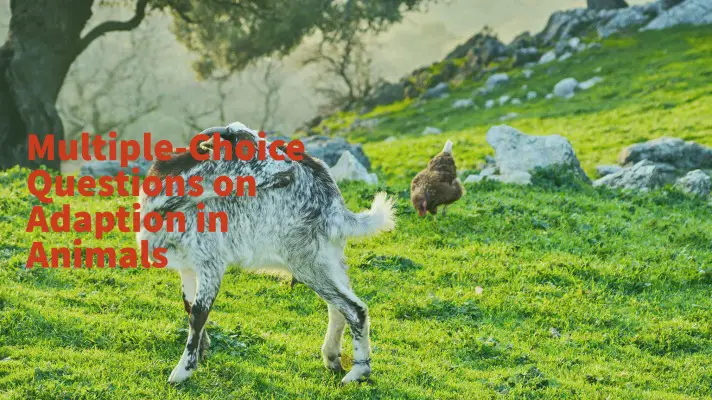Hello Readers! I hope that all of you are doing fine. I am here with a lot of Multiple-Choice Questions on Adaptation in Animals. While going through the Objective-type questions on Adaptation in Animals, you will come across some Amazing Facts on Adaptation in Animals and these are quite interesting. Let’s enjoy gaining more knowledge!
Further for getting the PDF version of this MCQ sheet in hand, click on the PDF downloadable button that you will get at the end of this article.

Multiple-Choice Questions on Adaptation in Animals
Here are some MCQ questions on Adaptation in Animals:
- Fresh-water habitats are:
- Rivers and lakes
- Seas and oceans
- Ponds
- (1) and (3) both
Ans: (4)
- Salt-water habitats are:
- Rivers and lakes
- Seas and oceans
- Ponds
- (1) and (3) both
Ans: (2)
- Extinction means:
- The capability of plants and animals to survive
- Disappearing of animals from existence
- The capability of flying in the air
- None of these
Ans: (2)
- Animals that spend a lot of time flying in the air are called:
- Terrestrial
- Aquatic
- Aerial
- None of these
Ans: (3)
- Aestivation means:
- Winter sleep of the animals
- Summar-sleep of the animals
- Blending-behavior of an animal with its surrounding
- None of these
Ans: (2)
- Hibernation means:
- Winter sleep of the animals
- Summar-sleep of the animals
- Blending-behaviour of an animal with its surrounding
- None of these
Ans: (1)
- Camouflage means:
- Winter sleep of the animals
- Summar-sleep of the animals
- Blending-behaviour of an animal with its surrounding
- None of these
Ans: (3)
- Which of the following animals are arboreal animals?
- Frogs
- Eagle
- Monkeys
- Elephants
Ans: (3)
- Plant eaters are known as:
- Herbivores
- Carnivores
- Omnivores
- None of these
Ans: (1)
- Monkeys are:
- Herbivores
- Carnivores
- Omnivores
- None of these
Ans: (3)
- Snakes are:
- Herbivores
- Carnivores
- Omnivores
- None of these
Ans: (2)
- When in water, frogs take breathe with the help of:
- Lungs
- Gills
- Flippers
- Moist skin
Ans: (4)
- Tadpoles breathe through:
- Lungs
- Gills
- Flippers
- Moist skin
Ans: (2)
- Squirrels are:
- Arboreal animals
- Aerial animals
- Terrestrial animals
- Aquatic animals
Ans: (1)
- The ship of the desert is:
- Zebra
- Ass
- Camel
- Horse
Ans: (3)
- The camel can drink up to __ liters of water at a time.
- 10-20
- 20-30
- 30-40
- 40-50
Ans: (4)
- Aestivation of animals is:
- Winter sleep of polar bear
- Summer sleep of desert animals
- Winter sleep of snakes
- None of these
Ans: (2)
- Walruses are found in:
- Antarctica
- Arctic region
- Deserts
- Polar region
Ans: (1)
- Which aquatic animals breathe through the lungs?
- Fishes
- Tadpoles
- Dolphins
- Salamanders
Ans: (3)
- Find the odd one:
- Eagles
- Polar bears
- Kites
- Vultures
Ans: (2)
- Which of the following is an Omnivore?
- Monkeys
- Eagles
- Hawks
- Foxes
Ans: (1)
- Which of the following is a herbivore?
- Kites
- Giraffes
- Rats
- Monkeys
Ans: (2)
- Find the odd one:
- Lion
- Monkeys
- Humans
- Squirrel
Ans: (1) as the lion is an endangered animal.
- Deer can run away to save themselves from their predators because of their:
- Strong legs
- Strong horns
- Thick skin
- Sharp claws
Ans: (1)
Quiz on Adaptation in Animals
Here is the Quiz for you:
I hope, that you have enjoyed the quiz and have got a very good score. Keep it up!
Now, here is a worksheet for you of 30 marks. Let me know how many marks you have got in this by commenting in the comment box.
Worksheet on Adaptation in Animals (30)
Fill in the blanks: (1×10=10)
- The place that forms an animal’s natural home is __.
- The plants all over the world are known as __.
- The animals all over the world are known as __.
- The process of disappearing animals from existence is called __.
- Animals that spend a lot of time flying in the air are __.
- Animals that live mostly on trees are __.
- Animals that live on land are known as __.
- Animals that live in water are known as __.
- Animals that live on both land and in water are known as __.
- The winter sleep of snakes, lizards, and frogs is known as __.
Give some examples of the following: (2×10=20)
- Terrestrial animals
- Aquatic animals
- Amphibians
- Aerial animals
- Arboreal animals
- Flightless birds
- Herbivores
- Carnivores
- Omnivores
- Endangered animals
Short Questions on Adaptation in Animals
- Name the breathing organ of the following animals:
Whale, frog, Flamingo, earthworm, butterfly, tadpole, shark, snake
- Why the camel is known as the ship of the desert?
- Indicate the natural habitat of polar bears. Mention any three adaptations of them.
- Mention any three adaptations of amphibians and aquatic animals.
- Mention the important adaptations of animals based on their food habits.
Answers:
A. Habitat,flora,fauna,extinction,aerial,arboreal,terrestrial, aquatic, amphibians,hibernation,
Conclusion
I hope that you all have enjoyed the article on Multiple-Choice Questions on Adaptation in Animals. This will surely help you in achieving a high score in your school examination / competitive examination. Wish you all the best!


